The food courts in airports are bright spots where people can take a bite during the hurly and burly of transit, yet they could easily become a nightmare due to lingering smells of various foods and stale air. Passengers wish to be in a fresh and comfortable environment, and it is necessary to provide this environment in the context of a high-traffic setting to ensure customer satisfaction and profit. One of the most efficient and cost-efficient means by which airport food courts can control odors, increase air circulation, and ensure passenger comfort is the use of commercial ceiling fans, and in particular, High-Volume Low-Speed (HVLS) fans. These fans increase ventilation in airport food court, supplement HVAC, and improve diner dwell time by dispersing smells over 10,000-20,000 square feet per fan at lower noise levels (under 35 dB). Architecture and commercial ceiling fans Airport solution is a strategic option to integrators of airport facilities, retail concession operators. As an organization with more than 20 years of ventilation experience, RTFANS improved the food court globally. We will discuss the challenges and impact, solutions and benefits, a case scenario and frequently asked questions.
The Challenge of Odors in Airport Food Courts
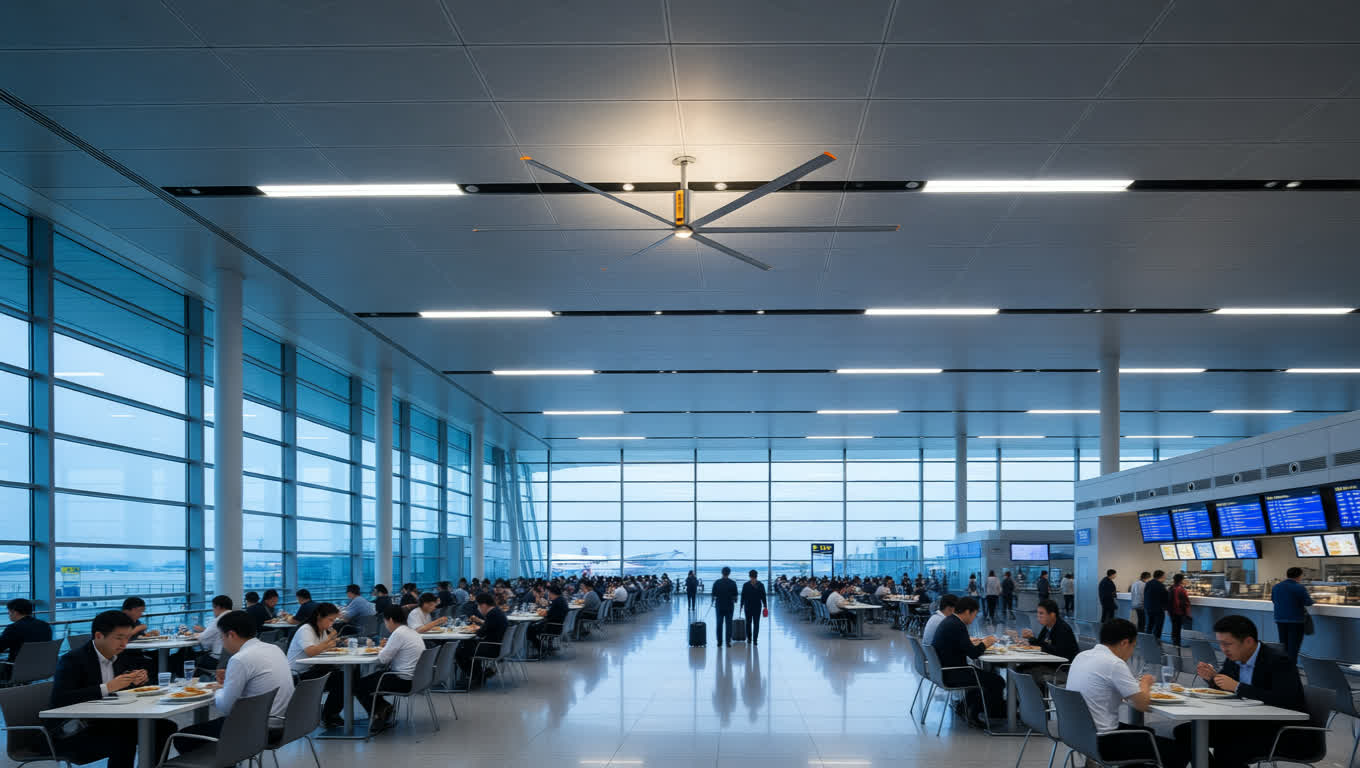
Airport food courts are a mixture of international food-think spicy curries, fried burgers, fresh coffees- and the mixture of smells creates a cacophony that gets overwhelming without management.
Diverse Cuisines Leading to Mixed Smells
Interspersed with sizzling stir-fries and baked pastries, food courts boast open kitchens where vapors and grease particles fly out, mingling to form a thick air. A study of air flow indicates that in 5,000 square feet, odors can travel 50-100 feet in a few minutes without air movement. This is compounded by high humidity due to steaming cuisine that causes odors to stick to surfaces and clothes.
Poor Airflow Causing Odors to Linger
Enclosed terminals have limited natural ventilation that results in stagnant air pockets that trap odors around diners. Open layouts frequently cannot be effectively circulated using HVAC systems alone, resulting in hot spots and allowing smells to creep into seating areas. This is not only objectionable during the wet weather or in the high seasons of traffic.
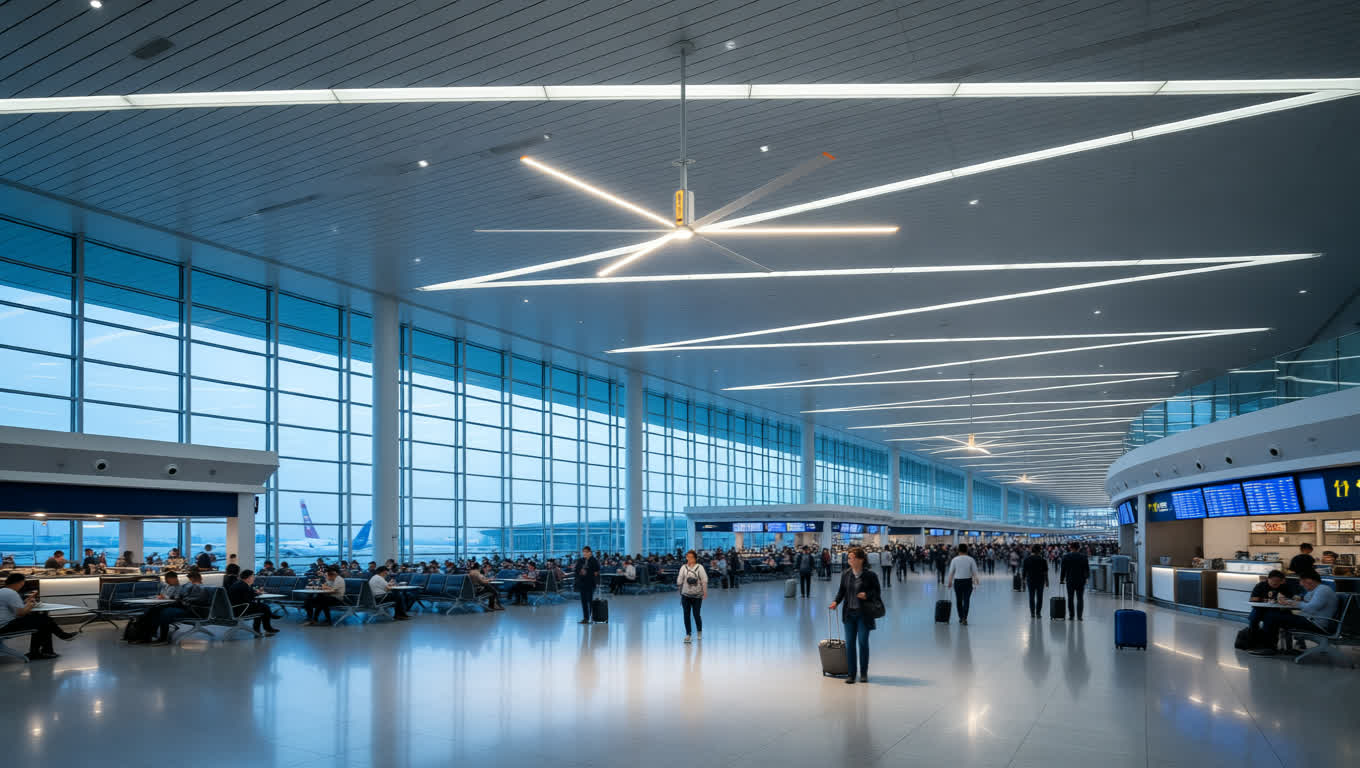
High Foot Traffic and Long Dwell Times
Airports accommodate 8.5 billion passengers every year where food courts manage 20-30 dwell time. Crowds increase body heat and CO2 which amplify odor. This will diminish comfort, as there will be no good airflow to extend visits and sales.
Impact on Passenger Experience and Airport Reputation
Smell in food courts has a direct impact on the traveling satisfaction and airport performance.
Unpleasant Odors Lowering Traveler Satisfaction
Smells that linger can make a fast meal turn into a bad one, reducing satisfaction levels by 15-20 points, according to Skytrax airport ratings. Poor air quality results in negative comments and social media criticism, so IATA standards focus on comfortable meal consumption to improve transit in general.
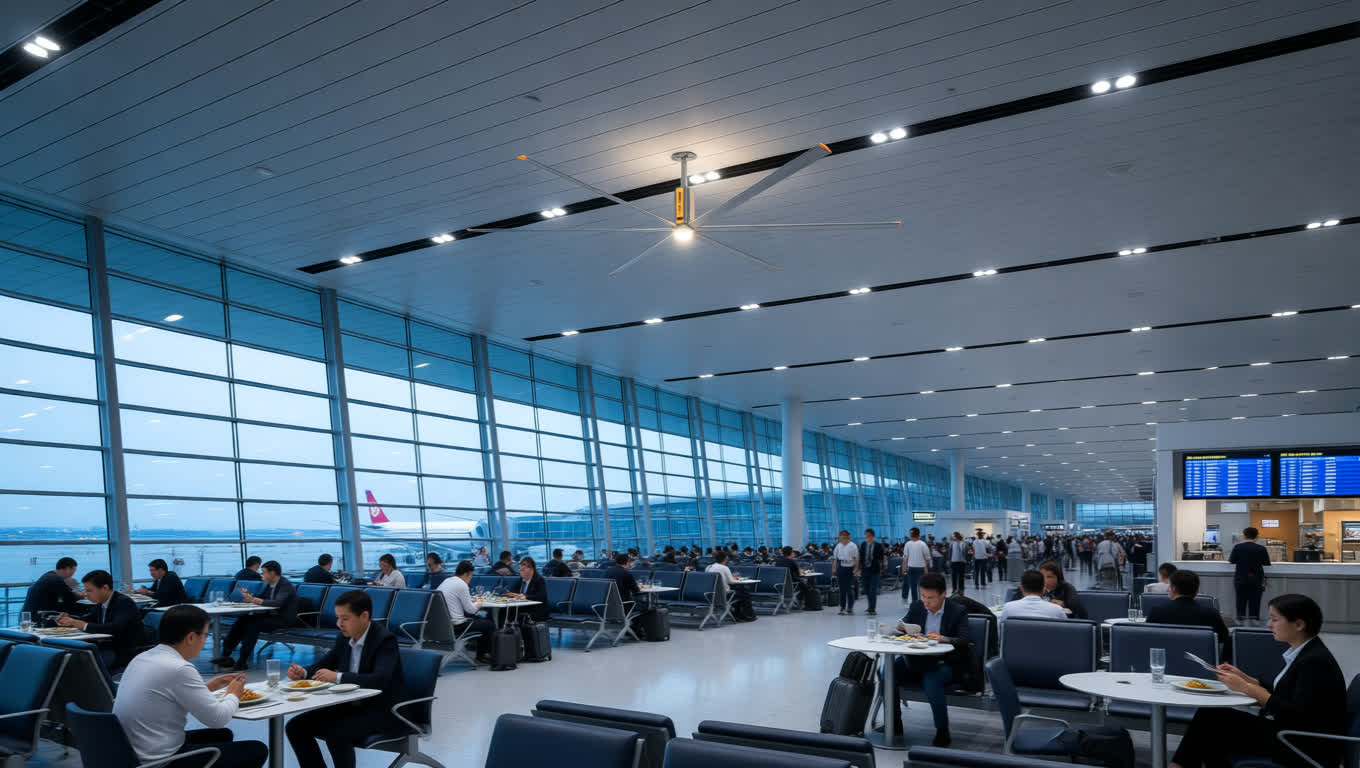
Food Court Comfort Influencing Revenue
A comfortable customer makes a purchase- plastic diners increase their spending on food and retail by 10-15%. Ineffective ventilation minimizes dwell time, which means that a mid-sized food court will lose between 5,000 and 20,000 dollars a day in revenue. It also has an impact on tenant retention and concession operators are harder to get to.
How Commercial Ceiling Fans Solve the Problem
The HVLS fans have the advantage of being able to deliver an intended odor control airport dining using a 8-24 feet fan; with velocities of up to 400,000 cubic feet per minute at low speeds (50-100 RPM).
HVLS Fans Create Steady Airflow to Disperse Odors Quickly
HVLS fans produce a low intensity, uniform airflow that spreads odors over extensive distances and dilutes them by 15-25%. In a food court the vapors are blown down to exhaust vents before accumulation. This odor control in airport food court works better than spot exhausts because the fans are able to cover 10000-20000 square feet at a time.
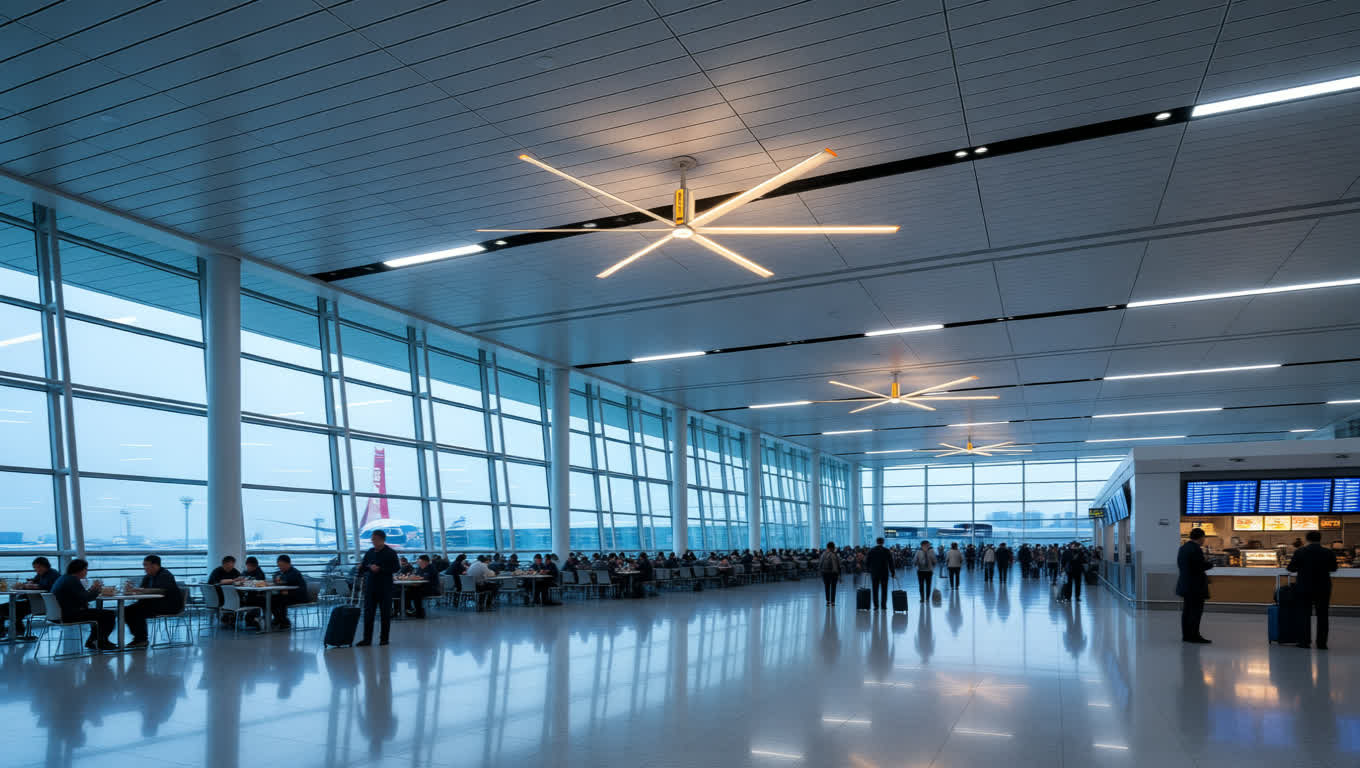
Improve Air Distribution, Preventing Stagnant Pockets
Fans destratify air, combining warm and odor laden higher air with cooler lower air in destratifying zones. Controllable speeds are used to regulate peak hours to prevent drafts.
Complement Existing HVAC and Exhaust Systems
HVLS fans will save you 20-30% of HVAC load, by distributing cooled air, thus permitting higher thermostats (3-5 degrees F, 4 percent per degree). They are more efficient in exhaust emissions and are ASHRAE 62.1 compatible in terms of IAQ..
Additional Benefits Beyond Odor Control
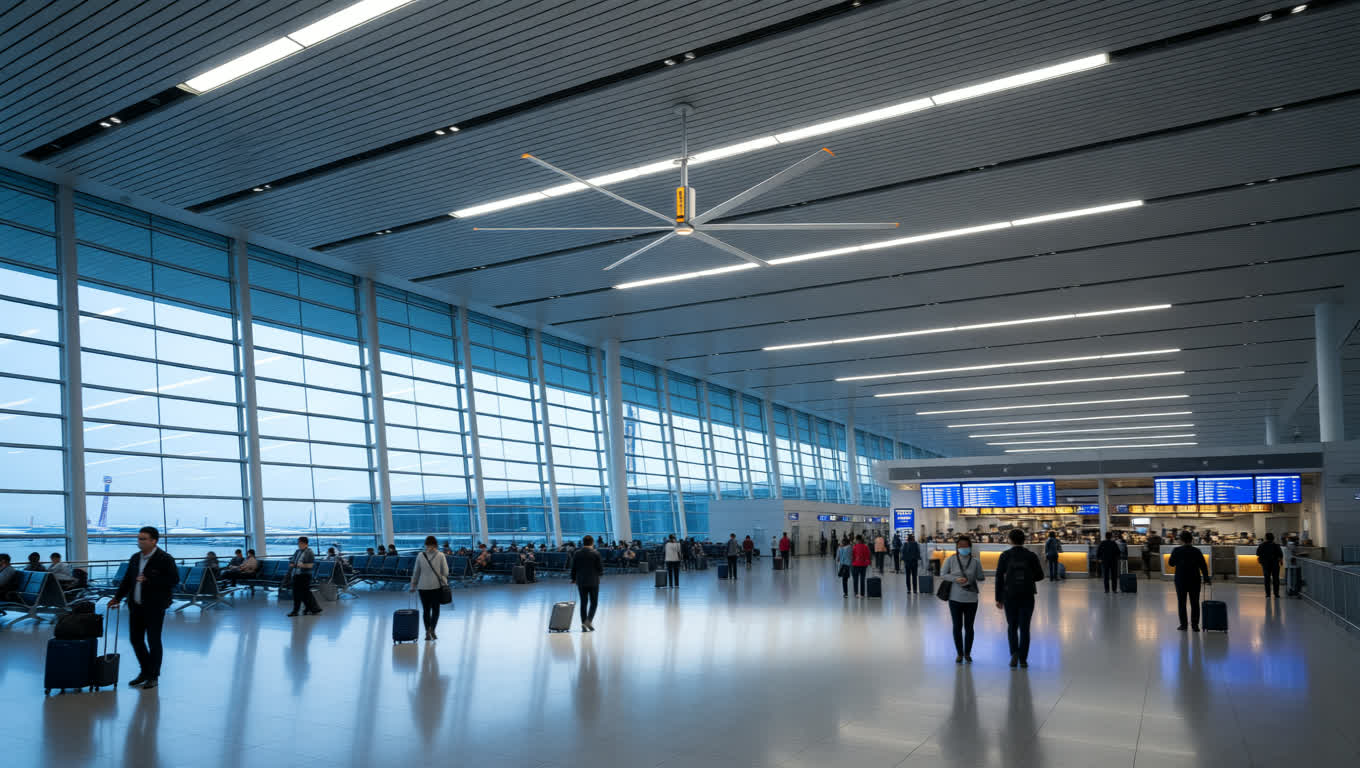
HVLS fans are not only beneficial in odor control but also they improve the functioning of food courts.

Energy Savings
Complementing HVAC can reduce energy consumption by 20-30 percent, which translates to savings of $3,000-10,000 each year in a 5,000-square-foot court. Their small power (less than 1.5 kW) is conducive to sustainable objectives.
Better Comfort for Diners and Staff
The wind-chill effect causes spaces to feel 5-7 degrees lower, which enhances satisfaction. An airport food test determined that improved airflow raises the dwell time by 10-15, enhancing revenue.
Noise-Free Operation
HVLS fans have low operation levels of less than 35 dB and conversations in such a facility are clear even when there are many people present (50-60 dB).
Case Scenario: A Busy International Airport Food Court
A 6,000-square-foot food court in a large Asian airport was facing odor complaints about mixed cuisines, and its satisfaction with passengers dropped by 18%. HVAC, in itself, could not cope with high traffic, which resulted in stagnant air. The four 14-foot HVLS fans also enhanced the airport airflow solutions, dispersing odors by 20 percent, and stabilizing temperatures. There were 25% fewer complaints, dwell time increased by 12% and revenue increased by 50,000 in a month. Energy expenses reduced by 22% (8, 000/year), which proved ceiling fans in airport dining ventilation.
FAQ: Common Questions About Ceiling Fans in Airport Food Courts
They release smell by 15-25 percent air flow to carry them to exhausts where they are contained to control odors airport dining- not eradicate but greatly lessen them.
No, HVLS fans supplements HVAC, this is better distribution in HVLS food court exhausts..
No, they work below 35 dB, conversations are quieter than, so that clean air airport dining areas are not disturbed..
Fans have been shown to improve comfort in busy airport food courts by creating even airflow and lowering perceived temperatures by 5-7oF.
Conclusion
The food court in the airport experiences issues of odor and airflows due to the different styles of foods and people who create a problem of satisfaction and income. Airport food court ventilation commercial ceiling fans, especially HVLS, distribute odors, enhance distribution, and supplement HVAC. The adoption of commercial ceiling fans in food courts should be in place in the airports as an odor-reduction strategy as well as an investment strategy to ensure that passengers are comfortable, the retail business is not affected, and the airports have a sustainable ventilation strategy. RTFANS has 20 plus years of experience of providing custom solutions. Today call us to make the most out of your food court– your passengers deserve a new experience.
